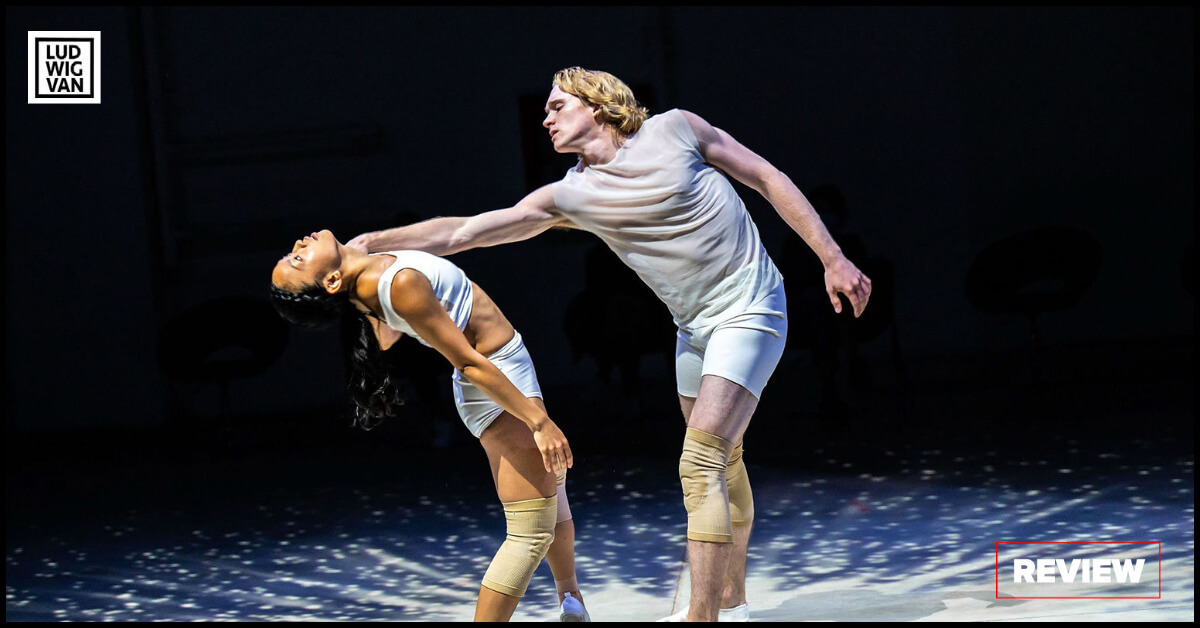
Lighthouse Immersive, Côté Danse and Mirari/Touch, direction and choreography by Guillaume Côté, projections and multimedia design by Thomas Payette, Lighthouse Artspace, Sept. 28, 2021 to Jan. 2, 2022 Tickets available here.
Talk about empire building. Lighthouse Immersive keeps carving out performance venues in the cavernous space formerly occupied by the giant printing presses of the Toronto Star.
Now comes a fourth spectacle to join Immersive Van Gogh, Jamie Allan’s Illusionarium, and Looking for the Dance, Mikhail Baryshnikov’s photography exhibit.
The new kid on the Lighthouse block is the dance piece Touch, an immersive choreography created by National Ballet of Canada principal dancer/choreographic associate, Guillaume Côté, and Montreal media artist Thomas Payette of Mirari Studio.
Apparently Côté was inspired to try his hand at immersive choreography when he toured the technology behind the Van Gogh exhibit. He went to Lighthouse with his ideas, and they commissioned him to create a dance piece. Côté had previously worked with Payette on Frame by Frame, which he choreographed for the National Ballet in 2018.
Touch is a duet that tracks a couple’s relationship through a multiplicity of moods. There are two rotating casts. I saw National Ballet dancer Larkin Miller and Toronto independent dancer Natasha Poon Woo.
The state-of-the-art technology employed in Touch is motion generated. Apparently there is a laser sensing system that can detect movement, which unleashes the visual projections. Thus, the dancers themselves are the epicentre of the light show.
The audience sits on swivel chairs that form a circle around the perimeter of the space, the swivel factor allowing us to follow the dancers who weave around the three enormous pillars that dominate the large room.
Clearly, Côté keeps growing in his craft as a choreographer, and Touch contains an impressive variety of movement expression. The 45-minute piece features a series of duets and solos that see Miller and Woo come together, fall apart, and sort of come together again, but as different people.
From the first flush of young love, they are older and wiser at the end, and Côté’s choreography conveys this evolving relationship of shifting control which Larkin and Woo dance with passion. Both are very talented movers.
Choreographically, Côté uses the entire space, including having the dancers literally climb the pillars and the walls. He has also incorporated some harrowing lifts, not to mention total body physicality in the solos. Love and longing is contrasted with frustration and rage. This is interior choreography. This is inner feelings writ large.
Payette’s projections follow the action like hand to glove. For example, the opening image is a sunburst of light surrounding the dancers, followed by an avalanche of shooting stars on the walls. This is the ecstasy of love.
Later, dark circles on the walls, and falling stars from the ceiling convey the agony. Towards the end of the piece, Payette introduces images of hands and eyes which are very unsettling. Squares on the floor move in disorienting fashion. Static bursts of colour are introduced into what has been a black and white palette, all of which convey the shifting emotions within the relationship.
The immersive experience breaks down the barrier between the dancers and the audience. While the projections bathe the dancers in the dance, they also embrace the audience as well. We are up close and personal with the dancers which is a heady encounter indeed, and because we are so close to them physically, we not only watch the dance, we actually feel their emotional roller coaster. Our two worlds have become one.
Antoine Bédard’s score contains mood altering electronica, but occasionally he includes well-known music like “Dido’s Lament” from Purcell’s opera Dido and Aeneas, or Strauss’s Blue Danube, which is like a momentary jolt of reality, only to be taken back into abstract sounds. The effect is like moving from the outside world into the couple’s insularity once again.
Lighting designer Simon Rossiter has ensured that the dancers can be seen amid the projections, while Krista Dowson has clothed them in unobtrusive white briefs with a halter top for the woman, and a shirt for the man. Both wear white running shoes. The very simplicity of the costumes enhances the intimacy we are witnessing.
In the final analysis, Touch is a piece that will open up dance to a whole new audience, simply because of the immersive experience, and this is a good thing.
As an art form, dance has always been willing to experiment, and Côté is following a long line of choreographers who have been willing to try the new and the different. Kudos to Côté and Payette for marrying dance and science.
#LUDWIGVAN
Get the daily arts news straight to your inbox.
Sign up for the Ludwig van Daily — classical music and opera in five minutes or less HERE.
- INTERVIEW | Actor Diego Matamoros Takes On Icon Walt Disney In Soulpepper Production Of Hnath Play - April 16, 2024
- SCRUTINY | Opera In Concert Shine A Light On Verdi’s Seldom Heard La Battaglia Di Legnano - April 9, 2024
- SCRUTINY | Lepage & Côté’s Hamlet Dazzles With Dance And Stagecraft Without Saying Anything New - April 5, 2024



